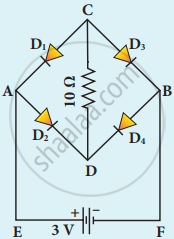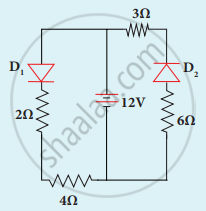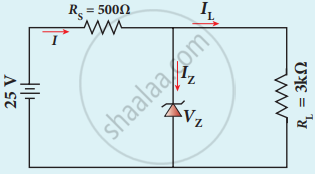Advertisements
Advertisements
प्रश्न
Explain the construction and working of a full-wave rectifier.
उत्तर
Full-wave rectifier: The positive and negative half cycles of the AC input signal pass through the full-wave rectifier circuit and hence it is called the full-wave rectifier. It consists of two p-n junction diodes, a center-tapped transformer, and a load resistor (RL). The center is usually taken as the ground or zero voltage reference point. Due to the center tap transformer, the output voltage rectified by each diode is only one-half of the total secondary voltage.

Full-wave rectifier circuit

Input and output waveforms
During positive half cycle:
When the positive half cycle of the ac input signal passes through the circuit, terminal M is positive, G is at zero potential and N is at negative potential. This forward biases diode D1 and reverse biases diode D2. Hence, being forward biased, diode D1 conducts and current flows along the path MD1 AGC. As a result, the positive half cycle of the voltage appears across RL in the direction G to C.
During negative half cycle:
When the negative half cycle of the ac input signal passes through the circuit, terminal N is positive, G is at zero potential and M is at negative potential. This forward biases diode D2 and reverse biases diode D1. Hence, being forward biased, diode D2 conducts and current flows along the path ND2 BGC. As a result, the negative half cycle of the voltage appears across RL in the same direction from G to C.
Hence in a full-wave rectifier both positive and negative half cycles of the input signal pass through the circuit in the same direction as shown in the figure. Though both positive and negative half cycles of ac input are rectified, the output is still pulsating in nature. The efficiency (η) of a full-wave rectifier is twice that of a half-wave rectifier and is found to be 81.2%. It is because both the positive and negative half cycles of the ac input source are rectified.
APPEARS IN
संबंधित प्रश्न
The barrier potential of a p-n junction depends on
(i) type of semiconductor material
(ii) amount of doping
(iii) temperature
Which one of the following is correct?
A diode is called a unidirectional device. Explain.
What do you mean by leakage current in a diode?
List the applications of light emitting diode.
Give the principle of solar cells.
What is an LED? Give the principle of its operation with a diagram.
Write notes on the photodiode.
Four silicon diodes and a 10 Ω resistor are connected as shown in the figure below. Each diode has a resistance of 1 Ω. Find the current flows through the 10 Ω resistor.

Determine the current flowing through 3 Ω and 4 Ω resistors of the circuit given below. Assume that diodes D1 and D2 are ideal diodes.

In the given figure of a voltage regulator, a Zener diode of breakdown voltage 10 V is employed. Determine the current through the load resistance, the total current and the current through the diode. Use diode approximation.

